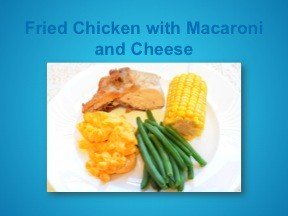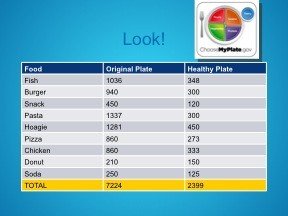12 Things We Learned from MyPlate
 Now that we have had a week to "play" with MyPlate and investigate all of the information thoroughly, we have learned a few things that go beyond their basic messages...1. The food groups basically stayed the same as they were in MyPyramid with regards to fruit, vegetables, whole grains, protein, and dairy. However, there were changes within each group.2. At least half of your grains should be whole grains, and MyPlate has the charts to prove it. (We previously thought that they had reduced the amount of grains that people should eat, but they did not - sorry for the confusion!).3. The protein group seems to emphasize more plant protein than it has in the past. Plus, the food group is now called "protein," rather than "meat and beans."4. The dairy group is no longer called the "milk" group. It emphasizes getting calcium with a minimal amount of added fat and sugar. It also goes so far as to mention dairy foods that are not a good source of calcium, like butter, which is now no longer a member of the food group. Instead, butter is part of the "empty calories" section.5. The MyPlate concept works, even if you are going to a fast food restaurant. We were surprised at how the calorie outcome would change if we took fried chicken and macaroni and cheese and put everything in the right proportions. A fried chicken dinner went from 860 calories to 333 calories, just because the chicken breast was cut in half and the mac and cheese was reduced to 1/2 cup. We filled the rest of the plate with salad and watermelon or green beans and corn, per MyPlate's call to fill half the plate with fruits and veggies at each meal.
Now that we have had a week to "play" with MyPlate and investigate all of the information thoroughly, we have learned a few things that go beyond their basic messages...1. The food groups basically stayed the same as they were in MyPyramid with regards to fruit, vegetables, whole grains, protein, and dairy. However, there were changes within each group.2. At least half of your grains should be whole grains, and MyPlate has the charts to prove it. (We previously thought that they had reduced the amount of grains that people should eat, but they did not - sorry for the confusion!).3. The protein group seems to emphasize more plant protein than it has in the past. Plus, the food group is now called "protein," rather than "meat and beans."4. The dairy group is no longer called the "milk" group. It emphasizes getting calcium with a minimal amount of added fat and sugar. It also goes so far as to mention dairy foods that are not a good source of calcium, like butter, which is now no longer a member of the food group. Instead, butter is part of the "empty calories" section.5. The MyPlate concept works, even if you are going to a fast food restaurant. We were surprised at how the calorie outcome would change if we took fried chicken and macaroni and cheese and put everything in the right proportions. A fried chicken dinner went from 860 calories to 333 calories, just because the chicken breast was cut in half and the mac and cheese was reduced to 1/2 cup. We filled the rest of the plate with salad and watermelon or green beans and corn, per MyPlate's call to fill half the plate with fruits and veggies at each meal.
 6. Food manufacturers have made us numb to what constitutes a real portion. It is shocking to bring home packaged fast food or processed snacks and put them on a plate. The portions are a lot bigger than we realized and the food is often very fatty -- much fattier than what we would make at home. I cannot ever remember frying fish and French fries on my stove for dinner.7. While you can't make the perfect plate every time, it helps to remember to fill half the plate with vegetables for lunch or dinner. And for breakfast, go half fruit. You could also use fruit as snacks and desserts later in the day.8. The recommendation for fruit and veggie consumption is still 4.5 to 5 cups per day. That is right in line with what WHO says to get, too. They recommend at least a pound per day.9. The USDA provides a wonderful list of vegetables in 5 different groups and encourages variety. We were reminded of that while reading their list because we tend to buy the same things over and over again.10. Beans and peas are considered both a protein and a vegetable.11. Dairy might be off to the side, but it is a good reminder to drink milk with your meals or include yogurt as a little side dish or dessert.12. Out of 8 meals and snacks, by using MyPlate as our template for makeovers, we saved a lot of calories:
6. Food manufacturers have made us numb to what constitutes a real portion. It is shocking to bring home packaged fast food or processed snacks and put them on a plate. The portions are a lot bigger than we realized and the food is often very fatty -- much fattier than what we would make at home. I cannot ever remember frying fish and French fries on my stove for dinner.7. While you can't make the perfect plate every time, it helps to remember to fill half the plate with vegetables for lunch or dinner. And for breakfast, go half fruit. You could also use fruit as snacks and desserts later in the day.8. The recommendation for fruit and veggie consumption is still 4.5 to 5 cups per day. That is right in line with what WHO says to get, too. They recommend at least a pound per day.9. The USDA provides a wonderful list of vegetables in 5 different groups and encourages variety. We were reminded of that while reading their list because we tend to buy the same things over and over again.10. Beans and peas are considered both a protein and a vegetable.11. Dairy might be off to the side, but it is a good reminder to drink milk with your meals or include yogurt as a little side dish or dessert.12. Out of 8 meals and snacks, by using MyPlate as our template for makeovers, we saved a lot of calories: Of course our store is ready with posters, tearpads, a free handout, and this PowerPoint show now! The PowerPoint deal is great - it is on sale and you get 3 shows -- 1 big one that has over 70 slides, 1 express show, and 1 mini show that is perfect for kindergarteners. PLUS 8 pages of handouts and 3 pages of games.GET MYPLATE EDUCATION NOW!
Of course our store is ready with posters, tearpads, a free handout, and this PowerPoint show now! The PowerPoint deal is great - it is on sale and you get 3 shows -- 1 big one that has over 70 slides, 1 express show, and 1 mini show that is perfect for kindergarteners. PLUS 8 pages of handouts and 3 pages of games.GET MYPLATE EDUCATION NOW!


